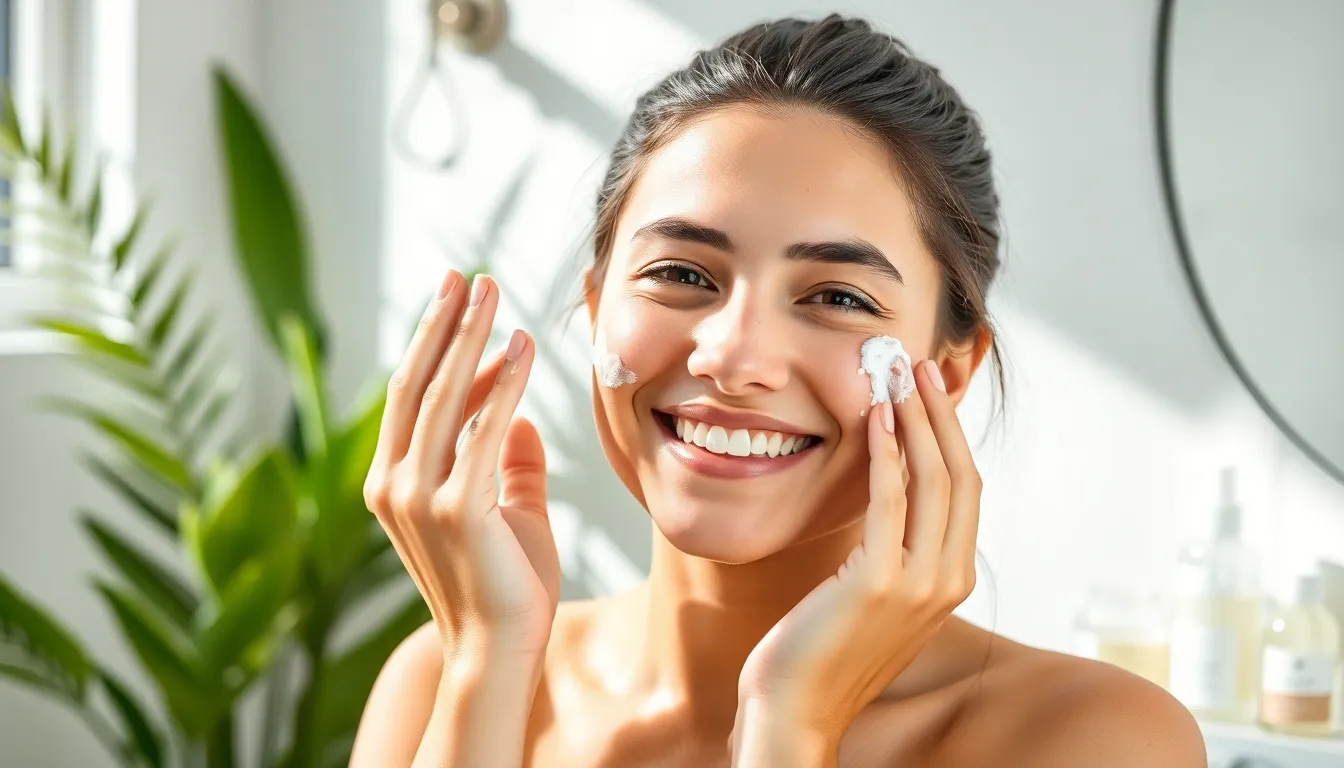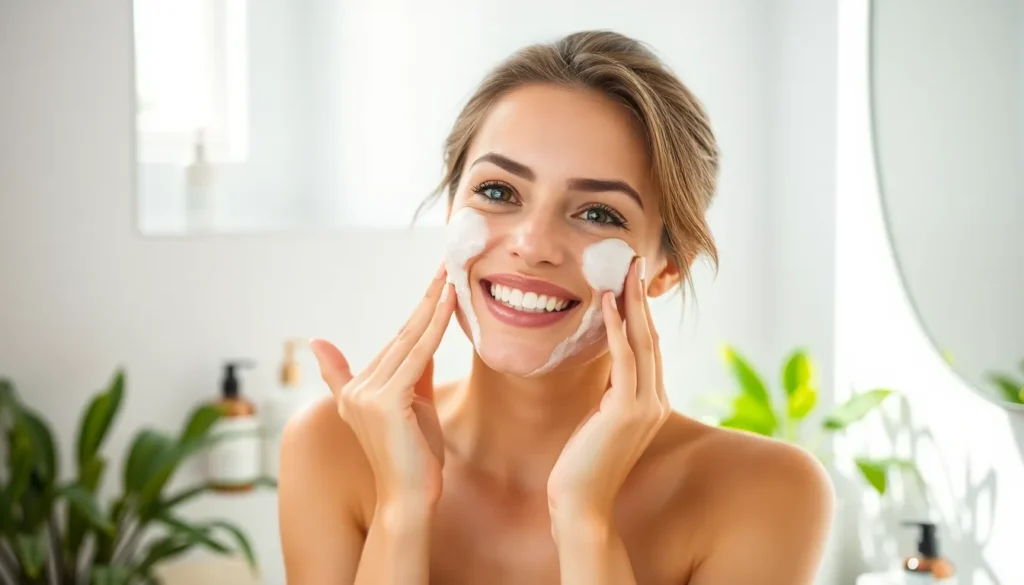Exfoliation might sound like a fancy spa treatment, but it’s really just your skin’s best friend in disguise. Think of it as a little spring cleaning for your face—sweeping away dead skin cells, dirt, and all those pesky impurities that make your complexion look like yesterday’s leftovers. Who wouldn’t want to reveal a fresh, glowing visage beneath that dull surface?
Table of Contents
ToggleUnderstanding Exfoliation
Exfoliation serves as a crucial step in skincare. This practice enhances skin texture and promotes a radiant appearance by eliminating dead skin cells and impurities.
What Is Exfoliation?
Exfoliation refers to the process of removing dead skin cells from the skin’s surface. It promotes cell turnover and allows new, healthy skin to emerge. Regular exfoliation leads to a smoother complexion and improves the effectiveness of other skincare products. Many people notice a reduction in clogged pores and breakouts when they incorporate exfoliation into their routine.
Types of Exfoliation
Two primary types of exfoliation exist: physical and chemical. Physical exfoliation involves using scrubs or tools to manually slough away dead skin. Common examples include sugar scrubs and exfoliating brushes. Chemical exfoliation utilizes acids or enzymes to dissolve dead skin cells without scrubbing. Alpha hydroxy acids (AHAs) and beta hydroxy acids (BHAs) are popular choices in this category.
Understanding both methods allows individuals to choose which best suits their skin type and concerns.
Benefits of Exfoliation

Exfoliation offers numerous advantages for skin health, promoting a radiant and youthful appearance. This practice transforms the skin by removing dead cells and impurities.
Skin Health Improvements
Exfoliating regularly fosters better skin health by preventing build-up that can lead to dullness and breakouts. Smoother skin surfaces result from regular exfoliation, which enhances texture and appearance. Increased circulation occurs during exfoliation, stimulating collagen production and leading to firmer skin over time. Renewed cells emerge more quickly when dead skin is sloughed off, contributing to a revitalized look. Reduced chances of clogged pores often follow consistent exfoliation, which ultimately decreases the occurrence of acne and other skin issues.
Enhanced Product Absorption
Improved absorption of skincare products becomes evident with regular exfoliation. Dead skin cells can obstruct product efficacy, making it harder for active ingredients to penetrate the skin. When exfoliation clears these barriers, serums and moisturizers can work more effectively. Enhanced hydration results from this improved absorption, allowing for better moisture retention. Additionally, users notice visible benefits from targeted treatments due to increased ingredient activity, leading to a more effective skincare routine overall.
Exfoliation Tips for Different Skin Types
Exfoliation techniques vary based on skin types. Understanding individual skin needs leads to better results.
Oily Skin
Exfoliating oily skin requires attention to using oil-free products. A gentle chemical exfoliant with salicylic acid effectively penetrates pores, reducing excess oil and preventing breakouts. Use this type of exfoliant 2-3 times a week. Look for lightweight scrubs that contain microbeads for manual exfoliation. Avoid harsh scrubs that can irritate the skin. Moreover, incorporating clay masks once a week can absorb excess oil and provide additional exfoliation benefits.
Dry Skin
Gentle exfoliation is crucial for dry skin to avoid irritation. Opt for cream-based exfoliants that hydrate while removing dead skin. Products containing lactic acid rejuvenate the skin without stripping moisture. Limit exfoliation to once a week to preserve skin’s natural barrier. After exfoliation, applying a rich moisturizer nourishes the skin and seals in hydration. Consider using enzymatic exfoliants suitable for sensitive areas, as they offer a soft approach and maintain moisture levels.
Sensitive Skin
Sensitive skin benefits from the least aggressive exfoliation methods. Use exfoliating products with natural ingredients like oatmeal or enzymes derived from fruits. Doing so minimizes the risk of redness or irritation. Stick to a bi-weekly schedule for exfoliation to maintain skin health. Patch testing any new product remains essential before full application. Incorporating calming ingredients like aloe vera post-exfoliation offers extra soothing effects and enhances skin recovery.
Best Practices for Exfoliation
Exfoliation practices enhance skincare routines and boost skin appearance. Adhering to best practices ensures optimal results.
Frequency of Exfoliation
Exfoliation frequency depends on individual skin types and conditions. Oily skin benefits from exfoliating two to three times weekly. Dry skin requires less frequent exfoliation, typically once a week. Sensitive skin should usually be treated with care, limiting exfoliation to every two weeks. Monitoring skin reactions helps determine the optimal frequency. Signs of irritation, excessive dryness, or breakouts indicate the need to adjust the routine. Following these guidelines promotes balance without compromising skin health.
Techniques and Tools
Various exfoliation techniques and tools cater to diverse skin needs. Physical exfoliation methods include scrubs with microbeads or soft brushes for a gentle approach. Chemical exfoliation utilizes ingredients like alpha hydroxy acids (AHAs) or beta hydroxy acids (BHAs) for deeper action. Choosing the right product is vital to match skin types; for instance, oily skin benefits from BHAs, while dry skin responds better to AHAs. Tools like cleansing brushes or konjac sponges can enhance the exfoliation experience. Always follow up with moisturizer to maintain hydration post-exfoliation.
Common Exfoliation Mistakes
Exfoliation can be beneficial, but certain mistakes can lead to adverse effects on the skin.
Over-Exfoliating
Over-exfoliating can strip the skin’s natural barrier. It causes irritation, redness, and increased sensitivity. Many people mistakenly believe more exfoliation equates to better results. Individuals with oily skin may feel tempted to exfoliate daily, yet this can lead to excess dryness. Signs like peeling or burning indicate the skin demands a break. Timing plays a crucial role; most skin types thrive with two to three exfoliations weekly. Adjustments based on skin response ensure protection. Planning a balanced routine promotes healthier skin.
Using the Wrong Products
Using the wrong products can negate the benefits of exfoliation. Not all exfoliants suit every skin type. For instance, abrasive scrubs may harm sensitive skin, creating further irritation. Similarly, those with oily skin could find alcohol-based exfoliants too harsh, worsening their condition. When choosing products, factors like skin type and concerns matter significantly. Ingredients such as salicylic acid work well for oily skin, while lactic acid caters to dry skin. Seeking professional advice or conducting patch tests helps identify suitable products. Following the right product recommendations enhances overall skincare effectiveness.
Exfoliation is a vital component of any effective skincare routine. By understanding the various methods and tailoring them to specific skin types, individuals can achieve a healthier and more radiant complexion. Regular exfoliation not only enhances skin texture but also boosts the absorption of other skincare products, maximizing their benefits.
It’s essential to listen to the skin’s needs and adjust exfoliation frequency accordingly to avoid irritation. With the right techniques and products, anyone can enjoy the numerous advantages that come from this rejuvenating practice. Embracing exfoliation can lead to a brighter and smoother complexion, making it an indispensable step in achieving glowing skin.








